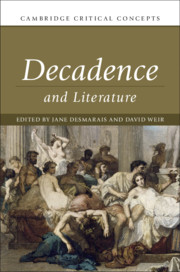Book contents
- Decadence and Literature
- Cambridge Critical Concepts
- Decadence and Literature
- Copyright page
- Dedication
- Contents
- Figures
- Contributors
- Acknowledgements
- Introduction
- Part I Origins
- Part II Developments
- Part III Applications
- Chapter 16 Decadence and Urban Geography
- Chapter 17 Socio-aesthetic Histories: Vienna 1900 and Weimar Berlin
- Chapter 18 Decadence and Cinema
- Chapter 19 Transnational Decadence
- Chapter 20 Decadence and Modernism
- Chapter 21 Modern Prophetic Poetry and the Decadence of Empires: From Kipling to Auden
- Chapter 22 The Gender of Decadence: Paris-Lesbos from the Fin de Siècle to the Interwar Era
- Chapter 23 Decadence and Popular Culture
- Select Bibliography
- Index
- References
Chapter 18 - Decadence and Cinema
from Part III - Applications
Published online by Cambridge University Press: 12 August 2019
- Decadence and Literature
- Cambridge Critical Concepts
- Decadence and Literature
- Copyright page
- Dedication
- Contents
- Figures
- Contributors
- Acknowledgements
- Introduction
- Part I Origins
- Part II Developments
- Part III Applications
- Chapter 16 Decadence and Urban Geography
- Chapter 17 Socio-aesthetic Histories: Vienna 1900 and Weimar Berlin
- Chapter 18 Decadence and Cinema
- Chapter 19 Transnational Decadence
- Chapter 20 Decadence and Modernism
- Chapter 21 Modern Prophetic Poetry and the Decadence of Empires: From Kipling to Auden
- Chapter 22 The Gender of Decadence: Paris-Lesbos from the Fin de Siècle to the Interwar Era
- Chapter 23 Decadence and Popular Culture
- Select Bibliography
- Index
- References
Summary
Decadent works, decadent themes, and decadent personalities figure prominently in the history of film, not only because of screen adaptations of novels and plays (there are at least three versions of Wilde’s The Picture of Dorian Gray and many more adaptations of Wilde’s plays), but also because of the proliferation of decadent themes and types, especially in the silent era. Examples include Theda Bara’s vamp persona and the frequent use of decadent settings for the silent mise-en-scène, such as pre-WWI Vienna in Erich von Stroheim’s The Wedding March (1928). Two key periods of decadence ? the Roman Empire and libertine France ? form the bases of the two modern films most identified with decadence: Federico Fellini’s Satyricon (1969) and Pier Paolo Pasolini’s Salò, or 120 Days of Sodom (1975). Some critics refer to Salò as the ‘last art film’ in cinema history, an assessment that reflects a sense that cinema itself has since entered a period of decadence. But time and again, some filmic form of ‘decadence’ has actually helped to enliven cinema and ensure its continuing artistic value.
- Type
- Chapter
- Information
- Decadence and Literature , pp. 300 - 315Publisher: Cambridge University PressPrint publication year: 2019
References
- 1
- Cited by

